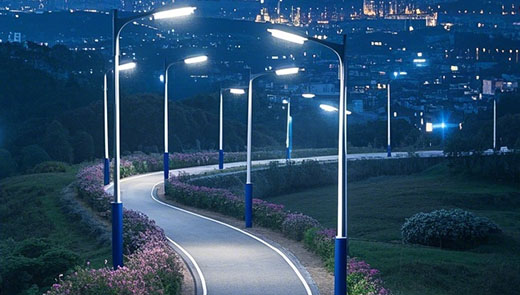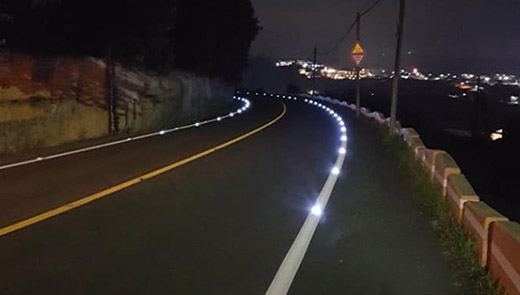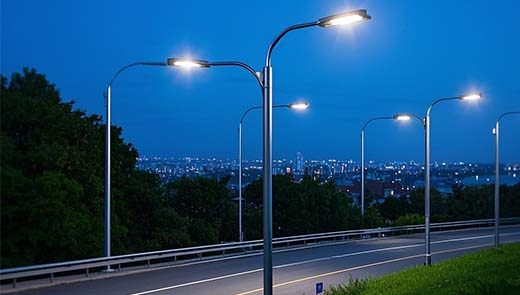Solar Road Studs: A Comprehensive Guide
In the endless flow of highway, whenever night falls or encountered bad weather, there are a group of “road guardians”will begin to play a role, they are solar road studs. These seemingly insignificant devices, by virtue of the power of science and technology, has become a key element to ensure the safety of driving at night and in complex environments. Let's start a journey of discovery about solar road studs to learn more about their past life, working mechanism, application scenarios, and their far-reaching impact on road safety in the future.

How were road studs invented?
One night in 1933, Percy Shaw of Yorkshire, England, was driving home from a pub party. As he was driving along a dark country lane, his headlights caught the eye of a cat, and the reflected light from the cat's eye alerted him to the situation and he redirected his car in time to avoid a potential accident. This experience gave Shaw an idea of whether he could create a device similar to a cat's eye and install it on the road to provide clear guidance to drivers traveling at night.
After much trial and error, in 1934, Shaw invented the first generation of reflective road studs - the cat's eye stud. The road studs consisted of a pair of reflectors and a rubberized base that gave off a bright reflection when illuminated by headlights. Once introduced, the cat's eye road studs was quickly adopted on roads across the UK and around the world.According to statistics, in the years following the introduction of cat's-eye road studs, the UK's night-time traffic accident rate dropped significantly by more than 30%. Over time, the traditional road studs have played an important role in ensuring road safety, but with the development of science and technology, solar road studs have come into being, bringing new changes to the field of road safety.
What are solar road studs?
Solar road studs, officially known as solar road marking, is a solar energy into electricity, and then realize the active light-emitting road safety warning equipment. With the traditional reflective road studs rely solely on reflective vehicle lights, solar road studs built-in solar panels, LED chips, batteries and photoelectric switches and other core components.Solar panels are usually made of monocrystalline or polycrystalline silicon, with a conversion efficiency of 15-20%. These solar panels are mounted on top of the road studs to maximize sunlight absorption. During the day, the solar panels convert the collected sunlight into electricity, which is stored in batteries. The batteries are mostly lithium batteries, which have the advantages of high capacity, long life, and high charging and discharging efficiency.
LED chip is the light source of the solar road studs, generally using high brightness, low power consumption of LED lamp beads. These light beads are installed on both sides of the road studs, facing the direction of vehicle travel. When night falls or the surrounding light becomes dark, the photoelectric switch will automatically sense the light change and trigger the LED chip to emit light. According to different designs and application scenarios, solar road studs are available in white, yellow and red colors, which are used to indicate different road messages.
In order to ensure that the solar road studs can withstand vehicle crushing and harsh weather conditions, their housings are usually made of high-strength engineering plastics or metal materials. These materials are corrosion-resistant, abrasion-resistant, impact-resistant, etc., which can effectively extend the service life of the road studs.
How do solar LED road studs work?
During the day, the solar panel will be converted into electricity, and through the charge management circuit will be stored in the battery. At this time, the photoelectric switch is off, the LED chip does not work. The charging management circuit can automatically adjust the charging current according to the battery's power status to avoid over-charging or under-charging, thus prolonging the service life of the battery.
When the night comes, the surrounding light intensity is reduced to a certain degree, the photoelectric switch will automatically sense and open. At this time, the electrical energy in the battery is released to drive the LED chip to emit light. The light emitted by the solar road studs can penetrate the darkness and clearly outline the road's contour, center line, edge line and various traffic signs. Moreover, in order to further reduce energy consumption, some of the solar road studs are equipped with an intelligent dimming system, which automatically adjusts the brightness of the LED chips according to changes in ambient light. In the darker light late at night, the road studs brightness will be increased accordingly; and in the case of moonlight or other auxiliary lighting, the road studs brightness will be appropriately reduced.

There are strict specifications for the installation of solar road studs. First of all, the road studs needs to have enough load-bearing capacity, can withstand heavy trucks and other large vehicles repeatedly crushed. When installing, make sure that the road studs is 5 - 8 mm above the road surface, not only to ensure that its luminous effect is not blocked, but also will not cause too much obstruction to vehicle traffic. According to the correct installation method, the service life of solar road studs can be up to 7 - 9 years, during which only a small amount of maintenance work is required, such as regular cleaning of the surface dust, to ensure that the solar panels and LED chips work properly.
Will solar road studs replace reflective versions?
Despite the many advantages of solar studs, there are still some challenges to replacing traditional reflective studs.
Cost factors
The manufacturing cost of solar road studs is relatively high, involving solar panels, batteries, LED chips and other complex components, while the traditional reflective road studs are simple in structure and low in cost. In some areas with limited funds, large-scale installation of solar pins may face economic pressure. In addition, the installation and maintenance of solar road studs require specialized technicians, which also increases the cost.
Light pollution problems
In some light-sensitive areas, such as nature reserves and residential areas, the brightness of solar road studs may cause light pollution, affecting the lives of residents and the ecological environment. In order to solve this problem, it is necessary to develop more intelligent solar road studs, so that they can automatically adjust the brightness according to the needs of the surrounding environment.
Applicability problem
In some areas with insufficient light, such as winter in high latitude areas or areas with more long-term cloudy and rainy weather, the charging effect of solar road studs may be affected, resulting in their inability to work properly. While the traditional reflective road studs is not limited by weather and light conditions, and can always maintain a stable reflective effect.
However, solar road studs also have advantages that can not be ignored. On the one hand, solar road studs are able to actively emit light and have a longer visual distance, providing drivers with more time to react. Studies have shown that the visual distance of solar road studs can reach more than 300 meters, while the visual distance of traditional reflective road studs at night is usually only 100-150 meters. On the other hand, solar road studs use solar energy as a source of energy and do not require an external power supply, making them easier to install and maintain, as well as being environmentally friendly. In addition, solar studs can be adapted to the standard iron shell of traditional reflective studs, which facilitates their retrofitting on existing roads.
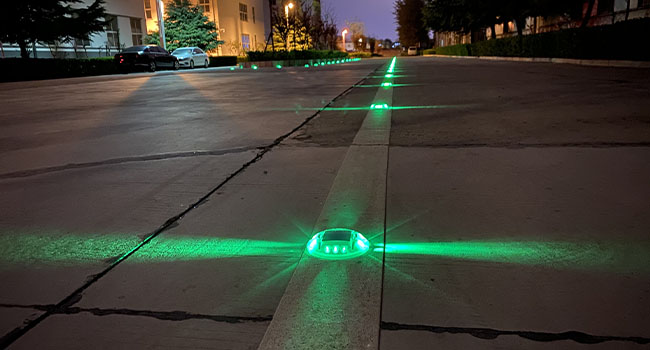
Where are solar road studs being used?
Highway
High traffic volume and high speed on highways require high clarity and visibility of road markings. Solar road studs are widely used in the center line, edge lines and entrances of highways. At night or in bad weather, the bright light emitted by solar road studs can provide drivers with clear road guidance, effectively reducing accidents such as tailgating and collision caused by poor visibility. For example, on some sections of the Beijing-Hong Kong-Macao Expressway, the nighttime accident rate was reduced by about 20% after the installation of solar road studs. In the construction section of the highway, solar road studs can also be used as temporary warning signs to remind drivers to pay attention to the construction ahead and slow down.
Rural roads
Rural roads generally have insufficient lighting facilities, and nighttime driving safety is a big hidden danger. The emergence of solar road studs provides an economical and effective solution for the safety of rural roads. Installation of solar road studs on dangerous roads such as curves, intersections and steep slopes can significantly improve the driver's recognition of road conditions and reduce the risk of accidents. Take a village in Sichuan Province as an example, after installing solar road studs on the main roads, the number of traffic accidents at night dropped by more than 30%, and the travel safety of the villagers has been effectively guaranteed.
Tunnels
Tunnel light is dark, and the vehicle driving environment is more closed, once the accident, the consequences are unimaginable. The application of solar road studs in tunnels can provide drivers with continuous and clear road guidance, helping them to maintain the correct driving direction. At the same time, the flashing lights of solar road studs can also attract the attention of drivers to avoid fatigue driving. In some extra-long tunnels, solar road studs are also linked with the tunnel lighting system, ventilation system, etc., to realize intelligent management and further improve the safety of tunnel traffic.
Scenic roads
Scenic roads are usually winding, and tourists are not familiar with the road conditions. Solar road studs can not only provide tourists with accurate road guidance, but also create a unique landscape atmosphere through different colors and flashing modes. For example, in some mountain scenic spots on the road, installed colorful solar road studs, these studs at night flashing colorful lights, and the surrounding natural landscape complement each other, not only to protect the safety of tourists, but also for the scenic area to add a bright landscape.
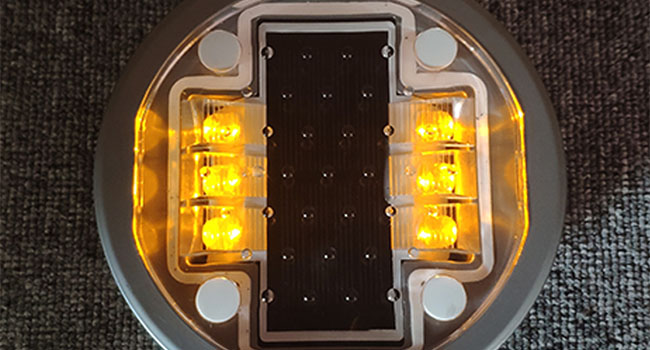
Benefits of solar road studs
Enhance road safety
Solar road studs create a clear “road of light” for drivers at night or in bad weather. Through the built-in high-brightness LED chip, it can steadily emit strong light, actively outline the road clearly, and in the dark night, the visible distance is far beyond the traditional reflective signs. After the actual data monitoring, in the installation of solar road studs road, the driver to bends, intersections and other key road conditions in advance of the perception rate increased by 60%, greatly reducing the rate of accidents. In winter snowstorms, snow often covers the road markings, seriously affecting the driver's vision. With a design that is 5 - 8 millimeters higher than the road surface, solar road studs effectively avoid being buried by snow and continue to provide drivers with accurate road guidance, reducing traffic accidents caused by unclear road conditions.
Reduced energy costs
The Solar road studs relies on a high-efficiency solar panel on top of the road studs that converts solar energy into electricity, which is stored in the built-in battery to provide its own power supply. There is no need to lay complex cable lines, which not only reduces the construction difficulty, but also saves a lot of preliminary laying and later maintenance costs.
A 30-kilometer-long new highway, for example, after the installation of solar road studs, the annual savings of electricity, line maintenance fees and other comprehensive costs up to more than 100,000 yuan. For some remote mountainous areas or island roads, solar road studs do not need to rely on external power grids, greatly reducing the cost of transportation infrastructure construction, becoming a very cost-effective road lighting solutions.
Environmentally sustainable
Solar energy as a clean energy, so that the solar road studs in the use of the process to achieve zero emissions. Compared with traditional lighting equipment, solar road studs avoid the emission of various pollutants generated by power generation, reducing pollution to the air and the environment.
In terms of energy saving and emission reduction, every 1,000 solar road studs installed can reduce about 5 tons of carbon dioxide emissions per year, helping cities and regions to achieve energy saving and emission reduction targets and promote sustainable development. In addition, the application of solar road studs helps to enhance the social awareness and utilization of clean energy, and plays a positive role as a model for environmental protection.
Sturdy and durable
The shell of solar road studs is made of high-strength and corrosion-resistant materials, which can withstand bad weather and repeated crushing by vehicles. After rigorous compression tests, it can withstand more than 5 tons of heavy pressure and maintain stable performance even in extreme environments such as high temperature, low temperature and humidity.
Its advanced sealing technology effectively prevents rainwater and dust from entering the interior, ensuring the normal operation of each component. Actual use shows that the average service life of solar road studs can reach more than 8 years, much longer than ordinary road signs. During this period, only simple cleaning and regular inspection are required, so the maintenance cost is extremely low, which provides long-term stable guarantee for road safety.
With the continuous progress of science and technology, solar road studs will also usher in new development opportunities. As an important innovation in the field of road safety, solar road studs have already played an important role in ensuring driving safety. It is believed that in the future, with the continuous development and application of science and technology, solar road studs may develop in the direction of intelligence and multi functionality, providing more reliable protection for people's travel safety.

